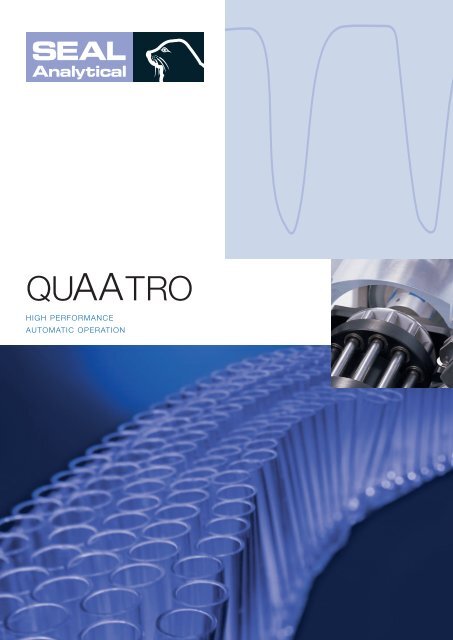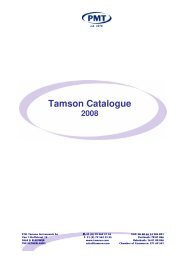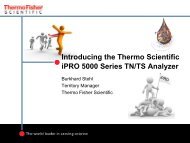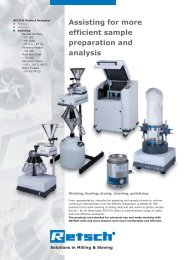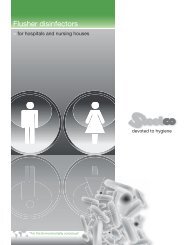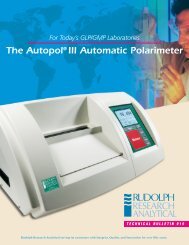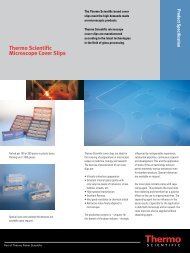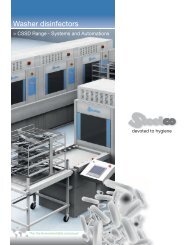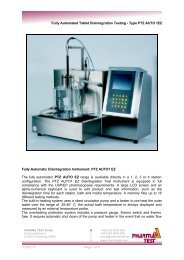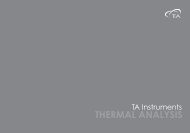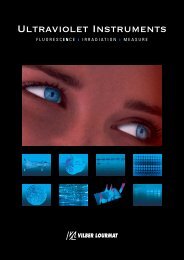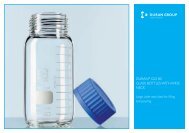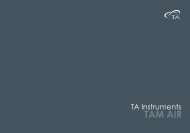QuAAtro english 2008_02.indd
QuAAtro english 2008_02.indd
QuAAtro english 2008_02.indd
Create successful ePaper yourself
Turn your PDF publications into a flip-book with our unique Google optimized e-Paper software.
QU<br />
AA<br />
TRO<br />
HIGH PERFORMANCE<br />
AUTOMATIC OPERATION
AA<br />
QU TRO<br />
THE LATEST IN A HISTORY OF INNOVATION<br />
HISTORY OF THE AUTOANALYZER<br />
THE BIRTH AND GROWTH OF CFA<br />
In the early 1950s Leonard Skeggs, a researcher in a clinical<br />
laboratory, had the innovative idea of adding air bubbles<br />
to a flowing reaction stream so that one sample after<br />
another could be introduced without interacting. From this<br />
idea the Technicon AutoAnalyzer was born in 1957.<br />
Within a decade it had become a dominant instrument<br />
type in automated analysis. In the late 1960s the AutoAnalyzer<br />
II was introduced, having air injection phased, smaller<br />
manifold components and a linear output. New techniques<br />
such as solvent extraction, automated digestion and continuous<br />
distillation were developed.<br />
By 1975 almost 8000 papers on CFA – more accurately<br />
termed SFA or segmented-flow analysis to distinguish it<br />
from flow-injection analysis FIA – had been published.<br />
MICROPROCESSORS AND HYDRAULICS<br />
After the complex definition of dispersion in segmentedflow<br />
streams had been derived by Technicon's Lloyd<br />
Snyder, micro-flow systems with higher segmentation<br />
frequency and sampling rates over 100/h appeared.<br />
At the same time, computers were built into the instruments,<br />
so that in a decade data calculation moved almost<br />
completely from ruler and calculator to dedicated computer<br />
or PC.<br />
TECHNICON, BRAN+LUEBBE AND SEAL<br />
By 1980 there was a clear division in system design<br />
between instruments intended for clinical and industrial<br />
use. In 1987 Technicon divided into separate industrial and<br />
clinical divisions, and the industrial division was bought by<br />
Bran+Luebbe. At the end of 2006 SEAL Analytical bought<br />
the continuous-flow business, so ensuring continuation of<br />
the AutoAnalyzer lineage.<br />
The CFA analyzers are designed and manufactured in<br />
SEAL's Technical Centre in Hamburg, Germany. Here the<br />
tradition of research and innovation is combined with German<br />
design skill and high quality manufacture to produce<br />
analyzers with exceptionally high performance and long<br />
working life.<br />
QUAATRO is the latest result of this fusion, and is the<br />
world's most highly automated CFA analyzer.<br />
DESIGN<br />
QUAATRO's design objectives were to reduce the detection<br />
limit, and to reduce the need for operator training by<br />
making the system monitor its own operation.<br />
Our engineers and chemists in Germany and Japan<br />
worked together with experts at the Netherlands Institute<br />
for Oceanographic Research, Royal NIOZ. Skilled users<br />
from the University of Hamburg helped to define and<br />
automate the tasks which are routinely performed by an<br />
expert user.<br />
The result is a closed, thermostatted system which checks<br />
its own performance and has a very low detection limit.<br />
QUAATRO AT A GLANCE<br />
QUAATRO COMBINES IMPROVED PER-<br />
FORMANCE WITH A HIGHER LEVEL OF<br />
AUTOMATION<br />
QUAATRO is an integrated system where only the sampler,<br />
PC and reagent bottles are external. Up to four<br />
methods can run at the same time on one console, and<br />
there is a special 5-channel version for nutrients in seawater.<br />
Two consoles can be combined to give an 8-channel<br />
system. The modular architecture allows easy expansion<br />
and adaptation.<br />
QUAATRO uses microflow hydraulics, which enables<br />
higher sampling rates with lower reagent consumption.<br />
It is ideal for laboratories with large numbers of relatively<br />
clean samples. QUAATRO's high speed and multi-channel<br />
design mean that 1000 results per day can be generated<br />
with ease on a typical system.<br />
SYSTEM FEATURES:<br />
High speed – sampling rate typically 1.5 - 2 times<br />
higher than a macroflow system.<br />
Low reagent consumption – per sample, typically<br />
one half to one quarter of a macroflow system.<br />
High reproducibility – about 0.4% RSD for most<br />
methods.<br />
Low detection limit – 0.1 µg/L P in seawater.
COMPACT AND FLEXIBLE<br />
A RANGE OF SAMPLERS<br />
INTEGRATED, ENCLOSED<br />
ANALYTICAL SYSTEM<br />
INNOVATIVE VALVE<br />
SOLUTIONS<br />
XY-2 SAMPLER (ILLUSTRATED)<br />
Up to 180 sample cups or tubes in<br />
2 racks.<br />
Separate rack for standards.<br />
Any size or shape of sample rack<br />
which fits into the sampler can be<br />
used.<br />
Dual-row option.<br />
XY-3 SAMPLER<br />
Similar to the XY-2, but with 3<br />
sample racks.<br />
The manifold and detector sections<br />
are designed as a whole and share the<br />
same temperature control system.<br />
Up to four methods in one console<br />
plus optional external detectors.<br />
Thermostatted manifold:<br />
37°C heating baths are not usually<br />
needed.<br />
1:1 compatibility with existing<br />
methods.<br />
Quick access to service components.<br />
Solenoid valves with opto-electrical timing<br />
for air injection replace mecha nically<br />
activated bubble injectors.<br />
8 silent valves for manifold air<br />
injection.<br />
Programmable method-specific<br />
bubble frequency.<br />
2 valves for independent flowcell<br />
segmentation.<br />
Optional flow valves for automated<br />
dilution and stream switching.<br />
Optional individual valves for each<br />
reagent for fully flexible automatic<br />
control.
THREE LEVELS OF AUTOMATION<br />
BEFORE...<br />
ELECTRONIC, HYDRAULIC AND CHEMICAL CHECKS<br />
With the automated pre-analysis checks you can be sure<br />
that key system parameters are within specification before<br />
starting a run.<br />
SYSTEM CHECK<br />
The electrical and optical performance of the photometers<br />
is checked by measuring the sample and reference transmission<br />
intensity and the lamp power supply parameters.<br />
Faults such as an aging lamp or a dirty flowcell can be<br />
diagnosed. Heater temperature is checked.<br />
WATER CHECK<br />
The water baseline is monitored for noise and drift. The<br />
bubble pattern, a sensitive indicator of correct hydraulic<br />
performance, is monitored to detect faults causing incorrect<br />
flow.<br />
REAGENT CHECK<br />
The reagents are connected and the bubble pattern is<br />
checked again. At this stage a missing reagent or surfactant<br />
can be detected. The reagent absorbance is<br />
recorded.<br />
TEST REPORT<br />
The report indicates out-of-spec parameters and can be<br />
used for system validation.<br />
CHART FROM A STARTUP<br />
SEQUENCE:<br />
Water baseline, reagent baseline and first peaks
DURING...<br />
RUN-TIME-MONITOR<br />
CHEMISTRY PERFORMANCE<br />
When the first peak appears the method sensitivity is<br />
checked to verify the reagents and flow rates. The run can<br />
be broken off at this point if the chemistry performance is<br />
out of specification. When the standards are through, the<br />
linearity and correlation are checked against specification.<br />
Again the run can be stopped.<br />
HYDRAULIC PERFORMANCE<br />
The bubble pattern monitor detects problems such as a<br />
reagent running out. Sample interaction can be measured<br />
to indicate a hydraulic fault causing high dispersion.<br />
STABILITY<br />
As recalibration standards appear during a long run the<br />
baseline and sensitivity drift are measured and checked.<br />
During the entire analysis the working temperature of the<br />
analytical system is continuously monitored.<br />
...AND AFTER THE RUN<br />
ANALYSIS AND SYSTEM LOGS<br />
DATA STORAGE<br />
At the end of a run three types of data are stored.<br />
METHOD AND SYSTEM DATA<br />
The values of all electrical, optical, hydraulic and<br />
chemistry parameters.<br />
ANALYTICAL DATA<br />
Raw data and calculated results for samples,<br />
calibrants and controls<br />
Method sensitivity and calibration linearity<br />
Operating conditions such as temperature.<br />
RAW DATA<br />
The absorbance factor for each individual liquid<br />
segment.<br />
DATA OUTPUT<br />
Data can be printed and sent to a file server. The data<br />
selection and format for electronic transfer is fully flexible.<br />
With the optional AACE GLP software, data on the server<br />
is verified and the local data can be deleted.<br />
HYDRAULICS<br />
Depending on the next use of the system, at the end of a<br />
run QUAATRO enters one of two states:<br />
Standby: pumps are switched to slow or intermittent,<br />
reagents remain connected and the temperature is<br />
maintained.<br />
Wash: reagents are washed out and the manifold is<br />
cleaned if necessary. Pumps switch to slow and the<br />
temperature is maintained in readiness for the next<br />
start or final shutdown.<br />
WARNINGS<br />
During an analysis the Run-Time Monitor constantly compares<br />
the measured result of each performance parameter<br />
with acceptable limits. Most of these limits can be set by<br />
the user, who can define what will occur when a limit is<br />
exceeded, for example to give a visual or audible warning<br />
or to stop a channel or the entire analysis.<br />
System log
QU<br />
AA<br />
TRO<br />
DESIGN FOR HIGH PERFORMANCE<br />
HYDRAULICS<br />
High frequency bubble segmentation is good for achieving<br />
high sampling rates on fairly simple methods such as<br />
those using only heated coils and dialyzers. However, the<br />
high elasticity of a long stream containing hundreds of air<br />
bubbles makes it more difficult to apply methods running<br />
at high temperature or which use distillation or a long reaction<br />
time.<br />
Bubble segmentation on QUAATRO is programmable so<br />
that the interval between bubbles can be short for simple<br />
methods and longer for more complex ones. Limiting the air<br />
volume on these methods greatly improves flow stability.<br />
Another advantage of programmable air injection is that<br />
the bubble interval can be selected so as to allow bubblethrough<br />
operation with flowcells having a variety of lengths<br />
and internal diameter.<br />
The optimum bubble frequency for each method is stored<br />
in the analysis configuration file and is automatically<br />
applied when the method is used.<br />
Warm air circulation<br />
TEMPERATURE<br />
Thermostatting the whole analytical system has several<br />
advantages. In many cases it is no longer necessary to<br />
use the 37°C heating baths traditionally employed to stabilize<br />
the temperature of reactions which are slow or sensitive<br />
to changes in ambient temperature, because a simple<br />
coil can be used. This reduces the cost of purchase and<br />
maintenance.<br />
At very high sensitivity the detector responds to changes<br />
in the refractive index of the liquid in the flowcell.<br />
Quick-connect strips make changing the tubes faster and<br />
easier<br />
QUAATRO's heated manifolds and circulating fars help to<br />
reduce the influence of changes in ambient temperature.<br />
The temperature of the analytical system, and of any hightemperature<br />
heating baths used for a method, is shown on<br />
the PC and can be set with a calibrated thermometer.
PUMP<br />
At the heart of the hydraulic system, QUAATRO's high<br />
precision micro-peristaltic pumps are manufactured to<br />
tolerances down to 8 µm to ensure that each liquid segment<br />
in the analytical stream contains the same volume<br />
of reagents and sample, an essential requirement for<br />
high reproducibility. The pump rollers are made from high<br />
grade CrMoV steel which then undergoes a two-stage<br />
surface treatment to increase its hardness and chemical<br />
resistance. Each roller is mounted on micro-needle bearings<br />
for smooth running and long life.<br />
PHOTOMETER<br />
QUAATRO's photometer is similar to the one used in<br />
AA3 HR, which is one of the most sensitive CFA detectors<br />
available. Every part has been optimized. A new<br />
lamp power supply delivers more stable current over<br />
a wider range. Detailed research has resulted in optics<br />
which increase the light transmission through the flowcell.<br />
The detector output goes directly into an A/D converter<br />
whose resolution is increased to 24-bit so as to<br />
reliably cope with lower detection limits.<br />
Triple pump assembly<br />
Flowcells are available in three diameters and three<br />
lengths, and can be used in bubble-through or bubblefree<br />
mode.<br />
LED light sources are standard for systems used on a<br />
ship and can be specified for other high performance<br />
applications.<br />
Optional GLP software package<br />
includes 21CFR Part 11 compliant<br />
functions including:<br />
Individually selectable passwordcontrolled<br />
access to every user<br />
function<br />
Password aging<br />
Administrator-determined relogon<br />
Analysis log with change control<br />
Checksum protected encrypted<br />
logs for analysis and system<br />
parameters<br />
Colorimeter cutaway drawing<br />
Data copy to server with optional<br />
verify and delete from workstation
QU<br />
AA<br />
TRO<br />
SPECIFICATION<br />
ANALYTICAL CONSOLE<br />
Incorporates pumps, fully enclosed and<br />
thermostatted analytical manifold and photometers,<br />
reagent / wash valves (option on<br />
some models) and automatic dilution system<br />
(option) for 1 to 4 simultaneous determinations<br />
(5 or 6 with detector extension).<br />
Two consoles can be combined to create a<br />
larger system.<br />
Leak detectors for manifold and photometers,<br />
with automatic warning and pump<br />
stop.<br />
SAMPLERS<br />
XY-2 SAMPLER<br />
Holds up to 180 cups.<br />
2 sample racks for:<br />
90 x 2 ml cups or 13 mm tubes<br />
60 x 4/5 ml cups or 16 mm tubes<br />
user-programmable sizes.<br />
Extra rack for 11 standards.<br />
Fixed or traveling wash.<br />
Dual-probe option<br />
XY-3 SAMPLER<br />
Holds up to 270 cups.<br />
As for XY-2 but with 3 sample racks.<br />
PUMPS<br />
12-roller peristaltic pump with needle bearings<br />
for each roller and fully floating platen.<br />
User programmable 3 step speed:<br />
intermittent, normal, high.<br />
Speed consistency better than ±1%.<br />
Easy-connect strip for quick pump tube<br />
changes.<br />
Emergency pump off switch.<br />
AIR / N 2 SEGMENTATION<br />
User programmable double-acting twinsolenoid<br />
air injection valves, each with<br />
capacity for 2 tubes.<br />
4 valves for manifold air injection plus two<br />
optional for different-frequency flowcell segmentation.<br />
Valve timing controlled by optical disk.<br />
Air injection delay up to 1000 ms individually<br />
programmable for each valve.<br />
1, 2, 3, 4 or 6-second air injection frequency,<br />
individually programmable for each valve.<br />
Long-life chemically resistant synthetic rubber<br />
air tubing with 1 year guaranteed lifetime.<br />
Compressed air / N 2 source via pump tubes<br />
or from house supply.<br />
MANIFOLDS<br />
1 mm glass manifold with platinum and<br />
sapphire reagent and air inlets.<br />
Compatible with current EPA and ISO<br />
standard methods.<br />
Temperature control.<br />
Manifolds and photometers thermostatted<br />
with circulating warm air.<br />
Optional heating baths with glass or PEEK<br />
coils for temperatures up to 120°C.<br />
1000 Hz proportional controllers for all heaters<br />
with PC temperature set and<br />
display.<br />
DIGITAL PHOTOMETERS<br />
Dual beam system with same-wavelength<br />
correction for high stability.<br />
Microprocessor-controlled digital signal<br />
processing.<br />
Light source krypton-filled tungsten lamp<br />
or LED.<br />
LED Photometer Wavelength<br />
270, 340, 350, 420, 460, 505, 520, 570,<br />
600, 630, 660, 820 or 880 nm<br />
24-bit A/D converter.<br />
Maximum absorbance resolution 1 in 3x10 6<br />
(equivalent to 0.3 ng/L PO 4 -P in a typical<br />
low-level method with a 10 mm flowcell).<br />
Baseline noise


